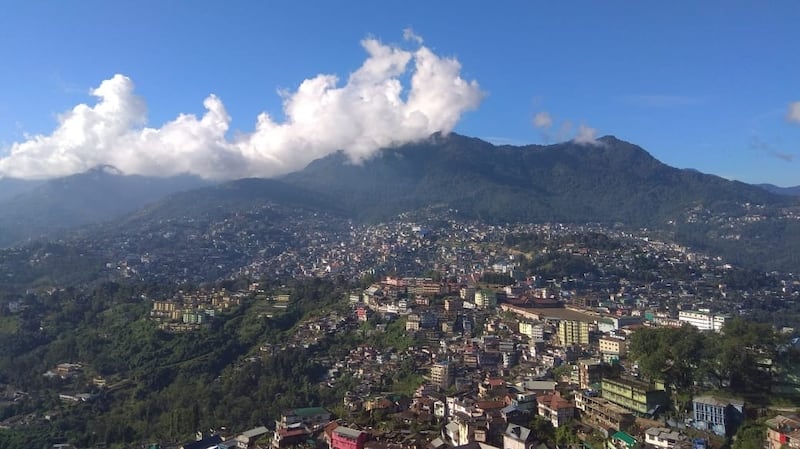I am a Naga writer, writing novels in English about Naga life so the rich stories of this land can speak to the world. In 2016 I took a research trip deep into tribal villages of the Naga Hills. This took me to thatched village compounds that have changed little for centuries. People work the land by hand, and show the forest utter respect. Without electricity, the nights are shrouded in darkness.
We Nagas are very aware that we are cohabitants of the natural world. We are taught from a young age how to conduct ourselves when we are out in the forests as the wooded areas are the acknowledged habitat of spirits. Most Nagas are Christians today but we have a nativised Christianity which accommodates all the spirit beliefs that I have written about in my new novel. It thrilled me to sit and listen to tribal tales.
One was an origin tale of the Chang Nagas. Many years ago, in the days of our ancestors, there was a period when an all-encompassing darkness covered the surface of the earth. Some found themselves trapped in the woods and the remainder were trapped within their homes. The dark time lasted and lasted and people were desperate to be saved. Their deliverance finally came and the light returned to the land. This time is called Nakshou Naknyu, the mother of all darkness.
Researching oral narratives is an art form in itself. The story is not over until there have been several tellings where meanings of words are revealed and connections made to other tribal tales of darkness. These several layers of story allowed ample room for my novelist’s imagination to participate and take it into other directions.
It grew into my new novel Spirit Nights. Characters took hold. One was a grandmother who possessed the great wisdom of her tribe passed down through the line of seers. Dreams form a powerful aspect of Naga spirituality. We believe we receive messages, and warnings about impending tragedies in dreams. There are several types of dream-metaphors and the “owner of the dream” interprets the metaphor accordingly.

An example: if one dreams of a big tree falling, it is a dream warning of the death of a parent or spouse. Several warning-dreams have come true in my life. The grandmother of Spirit Nights learns to have faith in the force of her dreams. She it was who strengthened the heart of her reluctant grandson, initiating him into the ways of the spirit world as he battled the tiger who had ‘eaten the sun’ and stolen the light.
Hunters tell the biggest number of spirit stories because they are the ones who travel furthest. When they hunt in virgin forests ( as they refer to areas where no one has hunted before) they report that those areas are teeming with spirits who imitate the voices of their friends and try to lure them away. Any hunter knows he should never call out his friends by name. Rather he whistles their names and communicates with them by whistling. This is possible since our language, Tenyidie, is a highly tonal language.
Village elders list at least 66 tribes that are found scattered over the original regions of the Naga Hills. Colonial administration mapped away large portions of Naga territory to what was then Burma and to the neighbouring Indian states. What remains is a very narrow version of the original, in the forested hills of India’s far north-east.
The Nagas have experienced more than 70 years of double colonisation: after the British left, the new Indian government forcibly brought the Naga tribes under its rule, establishing hard laws to crush the first resistance group into submission. One of those laws is still operational today. The Armed Forces Special Powers Act, instituted in 1958, allows a soldier of the Indian army in the rank of NCO to shoot to death, any Naga who, in his opinion, is acting suspiciously. Needless to say, the Act has led to many civilian deaths, the latest being the December 4th, 2021 killing of 14 young coal miners returning home after earning money to celebrate Christmas. The young men were in their twenties, the youngest victim was only 17.
The young coal miners were shot by the Indian army at close range without any prior interrogations. For the Naga people, the recent killings were a brutal reminder of the military rule controlling their lands and their freedom.
The devastated families of the victims went into mourning. I was newly back in Nagaland, after two years closed into my Norwegian home by the pandemic. The silence that settled over the rest of Nagaland at Christmastime was almost palpable. It was the silence of deep, unbearable mourning. An example of what happens to communities that live on the geographical peripheries of a big nation was seen in the manner in which national media presented the news of the killing. They insisted on featuring the army version, calling it a case of ‘mistaken identity’ overlooking the fact that the army had been caught hiding the bodies of the victims, trying to dispose of them.
The Naga people carried out a peaceful march covering 74km from the town of Dimapur to the capital town of Kohima to ask for justice. The families of the slain are still waiting for justice even as they “murmur name upon name” in an eerie echo of William Butler Yeats’ poem, Easter 1916.
This winter the beautiful Naga hills are tear-sodden. Naga musicians are performing tributes for the slain 14. We are going through another darkness waiting for wrongs to be righted, to some degree. And in its failure, the dark reaches into hearts and stays.
In fiction, mythical darkness is not impossible to dispel; the darkness created by man is far harder to destroy.
Easterine Kire, winner of the Hindu Prize for Literature, is the author of Spirit Nights, published by Barbican Press











